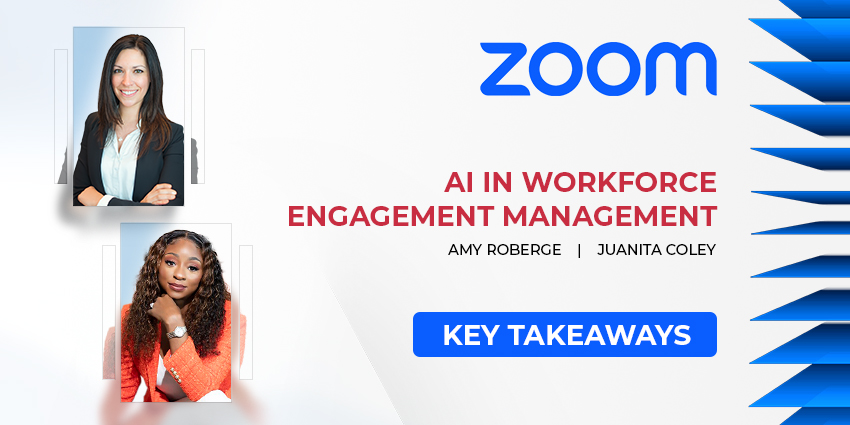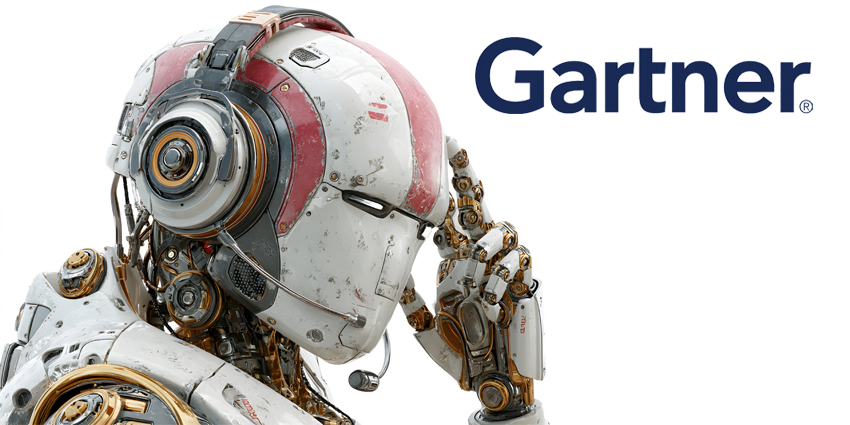While it may not be in your personal life, CX with your EX is an excellent idea in the business world.
Back in 2014, Starbucks observed that 87 percent of “customer affinity” for the brand is driven by how it treats its employees.
More recently, the Harvard Business Review found that 55 percent of execs believe it’s “just not possible” to provide a great customer experience without delivering a great employee experience.
Thankfully, the technology to establish those great employee experiences – and measure the impact on CX – is more accessible to contact centers than ever before.
Indeed, more CCaaS vendors are stepping into the workforce engagement management (WEM) space – serving up AI-driven forecasting, scheduling, quality monitoring, and so much more.
As this trend continues, the WEM space will evolve at a much faster pace.
Amy Roberge, Head of Global Contact Center Solution Engineering at Zoom, and Juanita Coley, Founder of Solid Rock Consulting, discussed what this evolution may look like during a recent CX Today webinar.
In doing so, they both exchanged the following expert takes on the future of the WEM market.
1. Quality Assurance and Workforce Management Come Part and Parcel
As CCaaS vendors dive deeper into the world of WEM, some have made quality assurance (QA) and workforce management (WFM) available on the same platform.
That convergence allows for a single user experience. QA data also becomes more readily available to WFM teams – and vice versa.
There are numerous use cases for such data sharing. For instance, in the case of a planner with access to QA data, they may:
- Spot the channel an agent performs best on and offer them more time on that channel.
- Isolate the queries an agent handles best and offer them more shifts when these queries typically enter the contact center.
- Optimize breaks so they come when the agent’s performance usually drops.
However, the single-user experience marries the capabilities of the traditionally siloed platforms to make new innovation possible.
As an example, Roberge teased a “self-healing schedule” capability that utilizes QA data – alongside data from other sources – to tweak schedules in real-time for planners. She said:
“Self-healing schedules powered by AI are going to save WFM managers so much time while also ensuring appropriate staffing even in the case of unexpected changes.”
Another possibility is a solution that triggers a break when an agent’s sentiment score stays low for a prolonged period. Such innovation would help safeguard employee well-being.
2. WEM Providers Expand Further Into Gamification and Learning Management
Many WEM vendors provide leaderboards that allow contact centers to gamify quality scores and reward the highest-performing agents.
Yet, with auto-QA solutions, it’s possible to track much more than who’s performing best.
For instance, brands can monitor when agents go above and beyond, record customer sentiment hot streaks, turn around a difficult call, and much more.
Building on this insight, vendors are now providing the tools for a much more comprehensive gamification strategy.
Take Zoom as an excellent example. Via WorkVivo, it offers the tools to gamify scenarios like all those above with shout-outs, awards, and badges.
As a result, everyone gets well-deserved recognition, not just the agents at the top of a leaderboard.
Moreover, as Zoom Quality Management and WorkVivo are available on the same unified platform – contact centers may build a strategy to recognize and reward agents doing good things.
Expect Zoom to encourage its clients to do precisely that. After all, as Coley states:
“Zoom thinks and talks about innovation in the context of how it will make agents’ lives better. This is no different.”
Interestingly, WorkVivo also offers podcast, survey, and learning management solutions that allow businesses to share knowledge in new ways.
As such, quality analysts and coaches have more ways to share best practices and make learning materials accessible to all types of learners.
3. Quality Assurance Solutions Enable “Teaching Moments” for Agents (and Outsiders!)
AI-augmented QA solutions now automatically flag the best and worst of customer-agent conversations for further analysis.
In doing so, the tech helps contact centers capture the most fruitful learning opportunities and move on from “lucky dip” quality monitoring.
Making this point, Roberge said:
“Supervisors and agents can reflect on the best conversations to reinforce positive behaviors. Meanwhile, they can address those not-so-good interactions to aid an agent’s learning.”
In addition, coaches can hold onto those positive conversations and share them with other agents in training to exemplify best practices and show them what “good” looks like.
Many contact center operations already do this. Yet, most only consider collecting “teaching moments” from an agent performance perspective.
In the future, more will use auto-QA to flag calls with “teaching moments” for contact center managers – such as an IVR mishap, knowledge base gap, or system error – outside the agent’s control.
Some contact centers will also use the technology to spot external issues that drive failure demand, flagging contacts to build a business case for action in the broader business.
4. WEM Becomes an Integral Part of Tech Implementations
According to a 2023 Gartner study, 45 percent of contact center agents avoid adopting new tech.
That’s an issue Coley has seen many times before. She said:
“You can implement a solution, sit there for months, and never get any ROI out of it because the wrapper is still on and it has not become part of the everyday process.”
Whether it’s because agents stick to their trusty old workflows or a supervisor doesn’t want to ditch their heavily customized spreadsheet, the issue spans many contact center stakeholders.
As such, Gartner advocates for a comprehensive legacy system shutdown strategy.
Yet, it’s also critical not to overlook the human element: agents must buy into new ways of working. In the era of cloud transformation, this has never been so crucial.
As such, more contact centers will likely engage with agents when defining the objectives of new tech, making buying decisions, piloting the solution, and bringing it onto the contact center floor.
WEM has a role here. For instance, QA offers a significant value-add when piloting the solution, as it may surface insights to optimize new agent workflows and determine best practices.
Most crucially, however, QA helps the contact center track a deployment’s success – in terms of agent and customer sentiment alongside adoption rates.
Catch Up on the Webinar
Zoom may be new to the WEM market, but its rapid innovation and plans to pull new capabilities into the space are exciting.
Already, it has released AI-driven forecasting, scheduling, and quality monitoring. Yet, that seems to be only a taste of what will come.
To dive deeper into Zoom’s current WEM proposition and objectives, watch the webinar in full here.
Alternatively, to learn more about its CX solutions, visit Zoom’s website: zoom.us









